The field of 16 teams was paired off over the course of January 27th and 28th in a single elimination playoff game, with the winning sides advancing to Group A to determine places 1 through 8 and the medals, while the losing teams played for places 9 to 16.
Switzerland defeated Norway 5-1 and Canada drubbed Yugoslavia 14-1 on the 27th to move into Group A. The next day the remaining six spots were filled with as Soviet Union won 19-1 over Hungary, Czechoslovakia beat Japan 17-2, Sweden defeated Italy 12-2, the United States beat Romania 7-2, West Germany narrowly beat Poland 2-1 and Finland hammered Austria 8-2.
In Group A play starting on January 29th, the Soviets beat the US 5-1, the Czechs beat the Germans 11-1 and Canada beat Switzerland 8-0. Canada won again the next day 3-1 over Sweden while Finland blanked the Swiss 4-0.
The US bounced back on the 31st with a 8-0 defeat of Germany while the Soviets were pushed by their main rivals Czechoslovakia but prevailed 7-5.
The Czechs shut out Finland 4-0 on February 1st while the Soviets crushed the Swiss 15-0. Sweden got their first victory 7-4 at the expense of the Americans.
Canada beat the Germans 4-2 and Sweden handed Finland it's second consecutive shutout 7-0 on the 2nd followed by Canada advancing to 4-0 with their 8-6 win over the United States in the only game on the 3rd.
Finland had the misfortune of facing the Soviets on the 4th and were held off the scoresheet for the third straight game in their 10-0 loss. The Czechs won 5-1 over Switzerland and Sweden kept pace with the Czechs with their 10-2 win over Germany.
With three days left in the tournament, things were coming into focus. Neither the Soviet Union or Canada had lost yet, while Sweden and the Czechs each had one loss.
Canada remained undefeated by winning 6-2 over Finland on the 5th while Sweden hammered the Swiss 12-0 and the Czechs did their part with a 7-1 win over the USA.
After a day off, play resumed with four games on the 7th. After Germany beat Switzerland 6-5 and Finland edged the US 3-2, the mighty Soviets beat Sweden 4-2 and Czechoslovakia dropped Canada from the ranks of the undefeated with a 3-1 win despite Canada leading 1-0 with less than ten minutes to play on a goal by future NHLer Rod Seling, but a collision with a Czechoslovakian player Miroslav Vlach knocked their goaltender Seth Martin from the game and his untested replacement could not hold off the Czechs, who scored 3 in the last eight minutes.
fends off an attack from Canada's Raymond Cadieux
That set up the final day's competition and the last four games on the schedule with all eight teams in action with the Soviet Union, Canada and Czechoslovakia all still in contention for the gold. Germany beat Finland 2-1 and the US was victorious over the Swiss 7-3 to set places 5 through 8 as the United States, Finland Germany and winless Switzerland.
The Soviets secured the gold medal with their close 3-2 win over Canada, finishing with a perfect 7-0 record and dropping the Canadians to 5-2. That set up the final game between 4-2 Sweden and 5-1 Czechoslovakia, which was won by the Swedes in dominant 8-3 fashion and leaving Sweden, Canada and the Czechs all even at 5-2 each.
The tie breaking procedure in use at the time was goal difference between the top four teams, which would have ranked the teams as Sweden (+1) for Silver, Canada (-1) for Bronze and the Czechs (-5) out of the medals in fourth.
However...
During the third period of the Czechs 8-3 loss to Sweden, the IIHF officials, led by Bunny Ahearne, met and changed the rules, deciding now that the tie breaker would be calculated based on ALL the games of Group A, not just among the top four teams! Sweden rose to +31 and remained in second, bu this flipped the bronze in favor of the Czechs (now +19) and dropped the Canadians (+15) to fourth - and out of the medals entirely and for the first time in their history.
Even worse, no one informed Canada of this change in policy. That night, the Canadian team got dressed in their finest team uniforms and made their way to the Ice Palace, only to then be informed there would be no medals for them.
The gold medal was the second for the Soviet Union, with their first coming in 1956, and the start of a run of dominance which would see them win four in a row through 1976. They were led in scoring by Konstantin Loktev, who had 6 goals and 15 points in 8 games and had four of the top eight scorers.
For die hards, places 9 through 16 went to Poland, Norway, Japan, Romania, Austria, Yugoslavia, Italy and Hungary.
Today's featured jersey is a 1964 Canada National Team Terry Clancy jersey. The 1964 Canadian Olympic Team was the first time that Canada had formed a dedicated national team of amateur university students who would compete together as a unit for a 43 game schedule prior to heading to the Games under the guidance and coaching of Father David Bauer.
Prior to 1964, Canada simply sent their national senior champions, occasionally with a few added players, to represent the entire nation. This approach worked fine during the early half of the 20th century, but could no longer excel by the mid 1950's against the might of the "amateurs" of Czechoslovakia and the Soviet Union, where their players were paid as soldiers or factory workers, but played hockey full time.
Terry Clancy is the son of Hockey Hall of Famer King Clancy and played in the NHL with the California Golden Seals and the Toronto Maple Leafs.

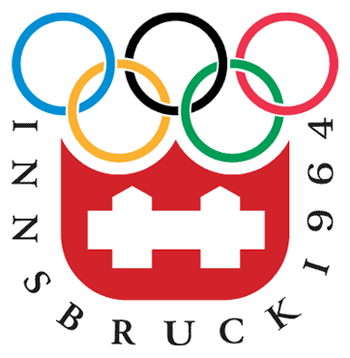
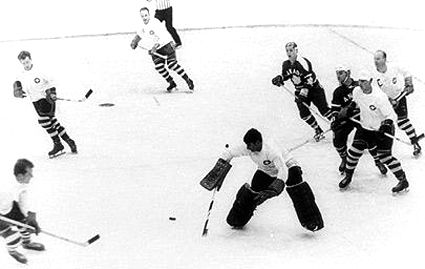

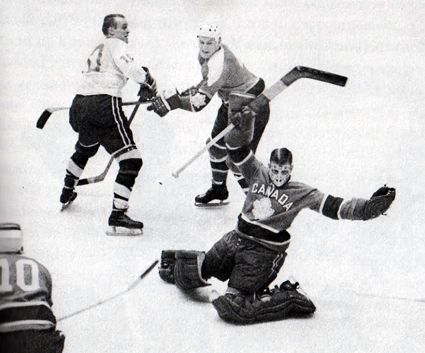
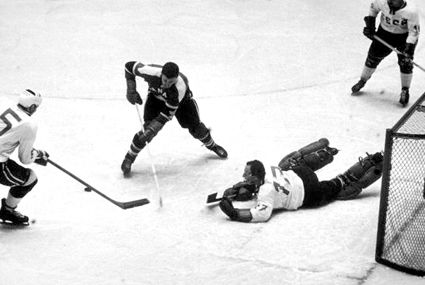
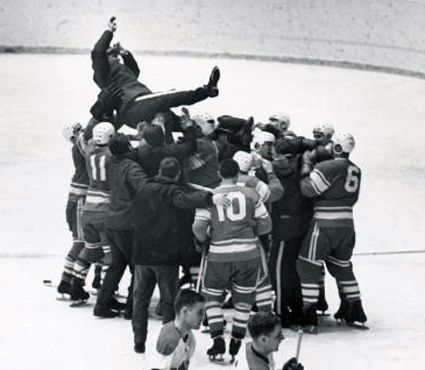
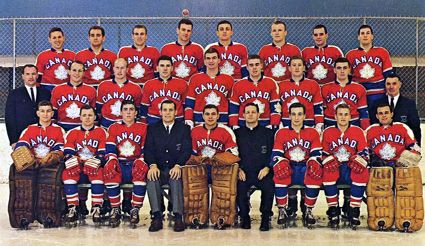
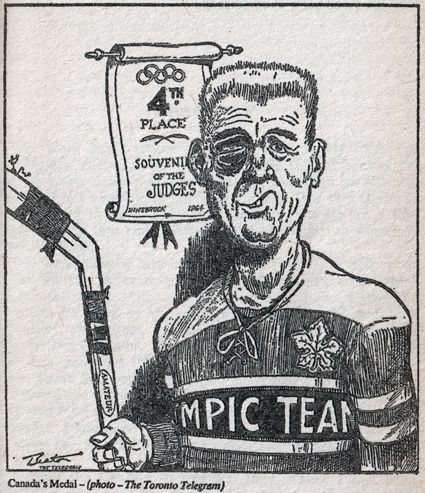

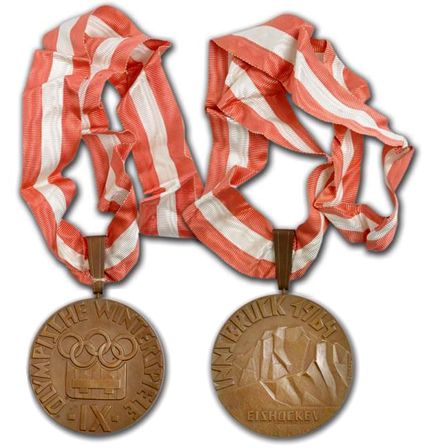
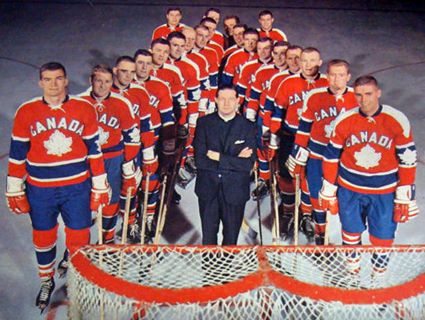
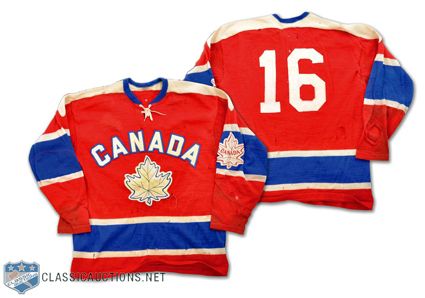










No comments:
Post a Comment
We welcome and encourage genuine comments and corrections from our readers. Please no spam. It will not be approved and never seen.